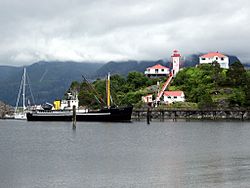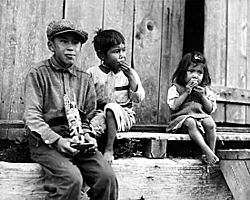Yuquot facts for kids
Quick facts for kids Yuquot |
|
|---|---|
| Friendly Cove | |

Nootka Lighthouse overlooking Yuquot
|
|
| Location | Nootka Island, British Columbia, Canada |
| Governing body | Mowachaht/Muchalaht First Nations |
| Website | https://www.yuquot.ca/ |
| Official name: Yuquot National Historic Site of Canada | |
| Designated | 1923-05-25 |
| Lua error in Module:Location_map at line 420: attempt to index field 'wikibase' (a nil value). | |
Yuquot, also known as Friendly Cove, is a small community on Nootka Island in British Columbia, Canada. It is located near Vancouver Island. About six people live there, including the Williams family from the Mowachaht band and two lighthouse keepers.
For many generations, Yuquot was the summer home of Chief Maquinna and the Mowachaht/Muchalaht people. These people are part of the Nuu-chah-nulth group. Around 1,500 people used to live there in 20 traditional wooden longhouses. The name Yuquot means "Wind comes from all directions" in the Nuu-chah-nulth language.
Yuquot is part of the Strathcona Regional District. However, like other Indian Reserve communities, it is not run by the regional district. The Mowachaht/Muchalaht First Nations are part of the Nuu-chah-nulth Tribal Council. This council brings together the governments of the Indigenous communities on the West Coast of Vancouver Island.
The Canadian government named Friendly Cove a National Historic Site in 1923. This recognized the importance of a Spanish settlement that was once there. In 1997, its importance to First Nations history was also recognized.
Contents
Yuquot's Rich History
The name Yuquot means "where the winds blow from many directions." It is sometimes called "the birthplace of British Columbia."
Early Visitors and Settlements
First Nations people have lived in Yuquot for over 4,300 years. They are from the Nootka Sound area. In the late 1700s, Nootka Sound became a key place where First Nations and European explorers met. It grew into an important center for the fur trade.
In 1774, Spanish explorer Juan José Pérez Hernández was the first European to see Yuquot. The region was officially claimed by the Spanish Empire in 1775. This happened during a trip by Spanish explorer Bruno de Heceta.
In 1778, British Captain James Cook arrived at the bay. He was on an expedition to find the North-West Passage. This was the first time Europeans were recorded landing there. After this, the Mowachaht people and the Europeans had regular contact for a while.
On May 5, 1789, Spanish explorer Esteban José Martínez started a settlement called Santa Cruz de Nuca. This was the first European colony in what is now British Columbia. It was the only Spanish settlement in what is now Canada. It was also the most northern Spanish settlement in the Americas. The settlement was protected by a fort called Fort San Miguel. It stayed active until 1795, when the Nootka Crisis was resolved.
The Nootka Crisis
Yuquot was the site of the Nootka Crisis. This event almost caused a war between Spain and Britain. Talks in Europe helped calm the situation. These talks led to the first Nootka Convention. Both nations sent a representative to Nootka Sound. Their job was to carry out the terms of the agreement.
In 1792, George Vancouver came for Britain. Juan Francisco de la Bodega y Quadra came for Spain. Quadra was also in charge of the Spanish settlement at Yuquot. He hosted Vancouver and his crew. Quadra and Vancouver had to negotiate because the Nootka Convention was not very clear. Also, both men had incomplete and confusing instructions from their governments. They talked for months but could not agree. The issue was sent back to the British and Spanish governments.
The main problem was how they understood the Nootka Convention. Vancouver believed the entire Spanish settlement should be given to him. Quadra thought there was nothing left to give based on the agreement. He offered to give a small cove in Nootka Sound. This was where John Meares had built a ship in 1788. He also offered the whole settlement if Britain agreed to set the border at the Strait of Juan de Fuca.
Chief Maquinna played a part in the talks. He pointed out the cove where Meares had built his ship. He swore that no land had ever been sold to the British. He said the Spanish were the rightful people at Yuquot. He also said the site should be returned to his people as soon as possible. Since they could not agree, Vancouver and Quadra left in late 1792. The settlement at Yuquot stayed under Spanish control until 1795. Then, the third Nootka Convention called for both sides to leave Nootka. After this, Maquinna and the Mowachaht people moved back to the site.
Yuquot in the 1800s
John R. Jewitt, an English blacksmith, was held captive in Yuquot for three years. This was from 1803 to 1805. He became Chief Maquinna's slave. This happened after the trading ship Boston was captured. The captain and all but one other crew member died. Jewitt's memories are an important record of Yuquot during that time.
Yuquot in the 1900s
In 1911, the Canadian government built the Nootka Lighthouse. It was placed on San Rafael Island. This is a small rocky island that looks over Yuquot. The original lighthouse was replaced in 1958 with the one you see today. It helps ships find their way through Nootka Sound.
Yuquot Today
Recently, the lighthouse has been home to an inshore rescue boat. It has a crew of three people. They have an 8-meter fast rescue boat to help people in need.
See also
 In Spanish: Yuquot para niños
In Spanish: Yuquot para niños


